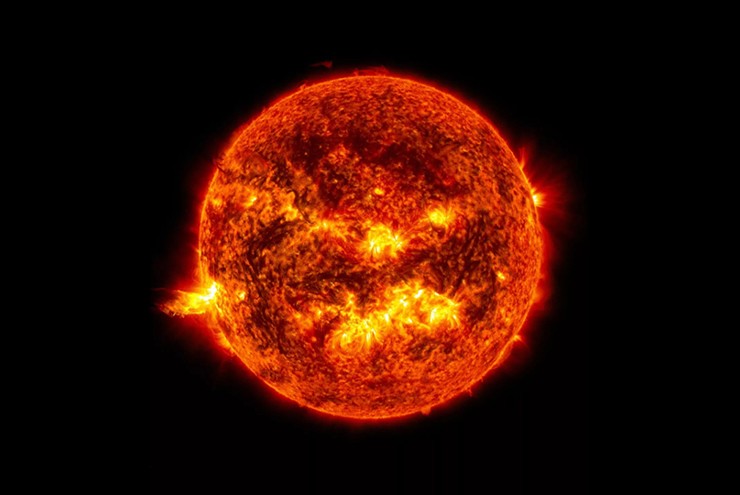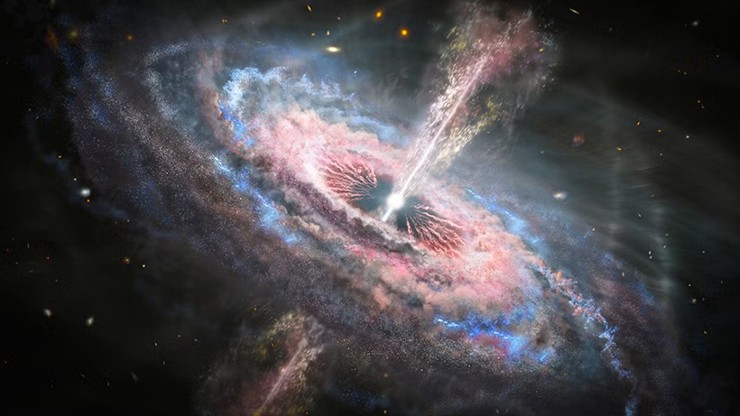Amazing Space Records You May Not Know
Although we have discovered a lot about space, there are still many interesting things waiting to be discovered. Here are some rare facts about space that not everyone knows.
The largest star is 2,150 times the size of the Sun.
The largest known star is Stephenson 2-18, also known as Stephenson 2-DFK 1. It is a red supergiant located in the constellation Scutum, approximately 18,900 light years from Earth. Stephenson 2-18 is estimated to be 2,150 times the size of our Sun, with a diameter of 3 billion km.

Description of Stephenson's star 2-18.
To put this enormity into perspective, if Stephenson 2-18 were placed in the Sun's place, its surface would reach the orbit of Saturn. It would take us 9 hours to travel around the circumference of Stephenson 2-18 at the speed of light, while it would take just 14.5 seconds to do the same for the Sun.
It is estimated that up to 10 billion Suns could fit inside Stephenson 2-18. The star's enormous size has led scientists to consider calling it a 'red supergiant' instead of just a 'supergiant'.
It's important to note, however, that we're observing Stephenson 2-18 from a very distant location, with a 50% uncertainty in the measurements. This means that the star's actual size may not be as large as estimated, but it's certainly still dozens of times larger than the Sun. There are other stars in the universe that are also larger, such as WOH G64 and UY Scuti.
The brightest object in the universe
When we think of bright objects in space, few people picture a black hole. In fact, black holes absorb light due to their strong gravitational pull, leaving us with nothing but blackness. However, the truth is more complicated. A black hole can produce light through the process of absorbing matter.

Black hole J059-4351 is 500,000 billion times brighter than the Sun.
About 12 billion light years away, there is a supermassive black hole called J059-4351. It has a mass about 17 billion times that of the Sun and is located at the center of a galaxy filled with matter. J059-4351's gravity is so strong that it consumes the equivalent of the Sun's mass every day.
As matter, including gas, rock, and molecules, approaches the black hole J059-4351, it is accelerated to nearly the speed of light and subjected to enormous friction. This process releases energy in the form of radio waves and visible light. This is also why meteors burn up when they enter Earth's atmosphere.
The light emitted by this process makes the accretion part of the black hole shine brightly, with a luminosity of 500,000 billion times that of the Sun. While nuclear reactions in the Sun convert less than 1% of matter into energy, the figure for black holes is up to 40%. It's truly astonishing.
The Sun accounts for 98.86% of the mass of the Solar System.
To humans, the Earth seems very large, but in fact it is only a small part of the Solar System. The mass of the Earth cannot be compared to other planets such as Jupiter and Saturn. Our Solar System consists of several planets, moons and asteroids, but most of the mass is concentrated in the Sun.

Specifically, 98.86% of the mass of the Solar System belongs to the Sun, while all other planets, Moons and asteroids account for only the remaining 1.14%. Notably, Jupiter is 2.5 times heavier than all other planets combined, while Earth accounts for only about 0.1% of the mass of the entire Solar System.
This shows how incredibly huge space really is. Even with all the planets combined, Jupiter is still more than twice the mass of all of them. The Sun, at nearly 100 times the mass of all the planets combined, is tiny compared to some of the other stars in the universe.
| Space is not only vast, it is also full of wonders. The facts we have mentioned so far mainly relate to the enormous size of objects in space, but there are many more amazing things. We will probably never discover all the mysteries of the universe, but each new discovery opens up new horizons of wonder. |
You should read it
- 10 interesting facts about black holes in the universe (Part 1)
- What happens when the Earth falls into a black hole?
- Discover the black hole closest to Earth, located in the star system that we can see with the naked eye
- Listen to the scary sound of a black hole 250 million light years from Earth announced by NASA
- Black force - a new force in the universe, becomes even more strange
- The newly discovered black hole contains anomalous characteristics, challenging most astronomical theories today
- Astrophysics professor teaches how to jump into a black hole so it's 'safe' and possible events
- The interesting fact about the universe is not quite the same as what we thought
May be interested
- UPDATE command in SQL Server
 in sql server (transact-sql) the update command is used to update the existing records on a table in a sql server database.
in sql server (transact-sql) the update command is used to update the existing records on a table in a sql server database. - Watch the journey of 'throwing' the ship into space at a speed of 1,600km/h using a mechanical arm
 the video above records the scene of a 3m long block of goods being thrown into the air by a mechanical arm at a speed of over 1,607 km/h (mach 1.3).
the video above records the scene of a 3m long block of goods being thrown into the air by a mechanical arm at a speed of over 1,607 km/h (mach 1.3). - The 7 largest objects people ever launched into space
 scientists have released a lot of objects into space, here is a list of the 7 largest objects of them, from the international space station to the hubble space telescope ... surely you will be amazed. when know how terrible they are.
scientists have released a lot of objects into space, here is a list of the 7 largest objects of them, from the international space station to the hubble space telescope ... surely you will be amazed. when know how terrible they are. - Half a year in space causes astronauts to lose bone permanently, equivalent to 10 years on Earth
 new research suggests that long-duration space missions can have permanent effects on astronauts' health, particularly on their skeletal systems.
new research suggests that long-duration space missions can have permanent effects on astronauts' health, particularly on their skeletal systems. - SPACE function in SQL Server
 the space function in sql server is used to return a string with the number of spaces specified in the statement.
the space function in sql server is used to return a string with the number of spaces specified in the statement. - MS Access 2003 - Lesson 19: Filtering data
 a filter allows you to limit the records to view. filtering data does not lose records, it only allows to determine which records you want access to display.
a filter allows you to limit the records to view. filtering data does not lose records, it only allows to determine which records you want access to display. - Please watch the first 8K video filmed in space
 recently, nasa shared the first 8k video footage shot in space and in the iss space station on its front page. if you have a tv or devices that support 8k resolution, you will have the opportunity to get closer to the experience in the space through this 3-minute video.
recently, nasa shared the first 8k video footage shot in space and in the iss space station on its front page. if you have a tv or devices that support 8k resolution, you will have the opportunity to get closer to the experience in the space through this 3-minute video. - Limit records in MongoDB
 to limit the records in mongodb, you need to use the limit () method. the limit () method takes a parameter in a numeric format, which is the document number you want to display.
to limit the records in mongodb, you need to use the limit () method. the limit () method takes a parameter in a numeric format, which is the document number you want to display. - Top 10 incredible records established by Indians
 here are some unbelievable but also interesting world records set up by the people in india that many people marvel at like the world's largest condom mosaic, the longest mustache world, use the fastest keyboard typing ...
here are some unbelievable but also interesting world records set up by the people in india that many people marvel at like the world's largest condom mosaic, the longest mustache world, use the fastest keyboard typing ... - 9 monumental peaks in the village gamers are Guinness World Records Gamer's Edition 2019 enrollment
 here are 9 faces who have reached the max level in some popular games like fifa 18, super mario 2, overwatch, fortnite, splatoon 2 ... they are the monuments of the gamer world, even the names of they were also honored in guinness world records gamer's edition 2019.
here are 9 faces who have reached the max level in some popular games like fifa 18, super mario 2, overwatch, fortnite, splatoon 2 ... they are the monuments of the gamer world, even the names of they were also honored in guinness world records gamer's edition 2019.










 New virus discovered in bats that can infect humans like Covid-19
New virus discovered in bats that can infect humans like Covid-19 Distinguishing common types of batteries on the market today
Distinguishing common types of batteries on the market today Is the death clock really able to accurately predict human lifespan?
Is the death clock really able to accurately predict human lifespan? Asteroid 2024 YR4's risk of colliding with Earth is increasing
Asteroid 2024 YR4's risk of colliding with Earth is increasing Shocking discovery from Hubble: Giant space target with 9 swirls
Shocking discovery from Hubble: Giant space target with 9 swirls 'Herbig-Haro' Super Object Revealed: A New World Appears
'Herbig-Haro' Super Object Revealed: A New World Appears